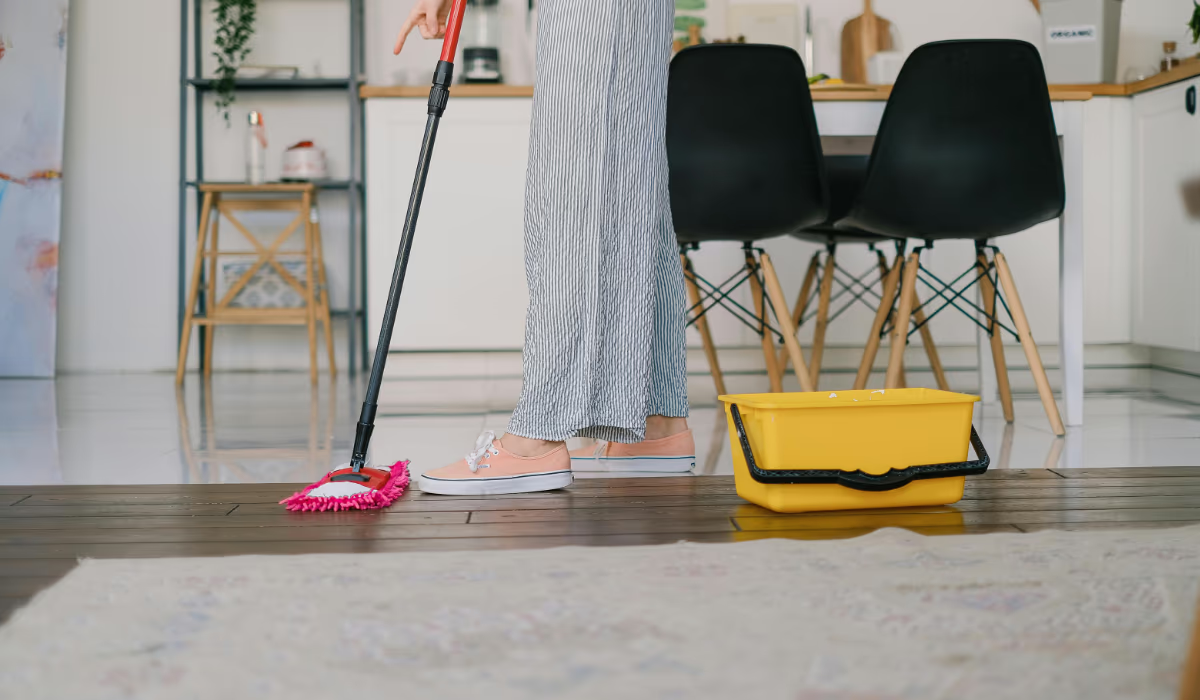Mopping isn’t just about wiping dirt—it restores hygiene, removes bacteria, and preserves your flooring’s finish. Done poorly, you may leave streaks, residue, or even micro-scratches. With the right method and tools, mopping becomes efficient and effective, not a chore you dread. Let’s go through how to mop properly so your floors look better and last longer.
Choose the Right Mop & Cleaning Solution
Different floor types demand different mops and cleaners. For smooth tile or vinyl, microfiber or flat mops work great; for textured surfaces, a sponge mop or String mop might suit better. Always pick a cleaning solution appropriate for your floor—wood floors need low-moisture or pH-neutral cleaners; stone may demand specialty blends. Avoid harsh cleaners or strong alkalis unless your flooring can tolerate them, as they may dull the surface.
Prepare the Floor Before Mopping
Before applying water or solution, sweep or vacuum thoroughly to remove dust, grit, hair, and debris. This prevents you from smearing dirt across the floor. Address sticky spots or stuck spills by spot cleaning with your cloth or a soft brush. Once the surface is ready, you can mop without pushing more mess around.
Techniques
Dip your mop into bucket water (mixed with the correct solution), wring it well so it’s damp not soaking, then start mopping in a consistent direction—often along the length of the room. Overlap strokes slightly to avoid missing patches. Rinse and wring your mop frequently to avoid applying dirty water back onto the floor. Use a second bucket for rinse water if possible for cleaner results.
Finishing Touches & Drying
After mopping the main floor area, go back over edges, corners, and under furniture where water may have missed. If possible, dry the floor using a microfiber cloth, squeegee, or ventilate the room to speed evaporation. Avoid walking on freshly mopped floors until they’re almost dry to maintain the clean finish.
Tips & Common Mistakes to Avoid
Don’t over-wet the floor—too much water can damage wood or seep into seams. Don’t ignore mop maintenance; clean or replace mop heads regularly to prevent odor or residue. When the solution in your bucket becomes visibly dirty, replace it. Also avoid harsh chemicals on sensitive floors and always follow manufacturer recommendations.
Conclusion
Mopping correctly transforms floor cleaning from a tedious task into a quick, effective routine. Use the right mop, choose a suitable cleaning solution, prepare the floor, mop with a consistent pattern, rinse your mop often, and finally dry or ventilate to finish. Avoiding common mistakes keeps your floors shining without buildup or damage. With practice, your “best way to mop” becomes second nature.
FAQs
How often should I mop my floors?
High-traffic areas benefit from once or twice weekly mopping; less used rooms might need it only every 1–2 weeks. Always do spot cleans when spills happen.
Can I use vinegar or homemade cleaners?
Yes, for many tile, vinyl, or sealed floors a diluted vinegar solution works. Avoid vinegar or acidic cleaners on natural stone or wood unless they’re safe for those materials.
Is steam mopping a good idea?
Steam mops work well on sealed floors and for sanitizing, but avoid them on unsealed wood or surfaces that may absorb moisture.
How do I remove streaks or cloudy residue after mopping?
Use clean water for a final rinse pass, and dry promptly. Also ensure you used the correct dilution of cleaner and wrung out your mop properly.
Can I mop laminate or wood floors the same way I mop tile?
Not exactly. Use minimal water, well-wrung mops, and cleaners designed for wood or laminate. Excess water and strong cleaners can warp or damage wood surfaces.







